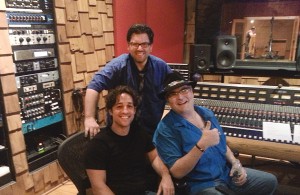Jack Miele always has to find the right balance. Sometimes it’s as simple as fiddling with the levels on the main board at the Music Shed Recording Studio, and sometimes he has to spend the better part of an hour setting up one system to record one harmonica.
Miele has a vast array of high tech recording equipment at his fingertips and the chops to know how and when to use it. Tell him what you want from a session and you can see the wheels spin furiously behind his eyes until every cog fits perfectly into place and he springs into action.
The Grammy nominated audio engineer and Molly Ringwalds guitar player moved to the Music Shed recently after Fudge Recording Studio, which he owned along with Better Than Ezra’s Tom Drummond and Shane Theriot, closed in April.
Earlier this month, Grammy winners Blues Traveler hired Miele to produce and engineer several tracks for their next album. Among Miele’s first priorities: making sure John Popper’s signature harmonica sound came across as it should.
“It took probably 40 minutes just for us to figure out the routing to get the whole thing hooked up,” Miele said. “It sounds like a lot, but the band was super cool and patient. We had to get a bunch of adapters and Y cables and figure out how to split this one signal in all these different ways.”
Popper uses a button attached to his harmonica mic with electrical tape that controls the speed on his Leslie amp’s rotating drum, complicating things even more for sound engineers like Miele and his assistant engineer Ryan Brown.
“John Popper had a very specific sound in mind that we sat there and we tweaked,” he said. “We used Neve and API preamps. The Music Shed doesn’t have any bad preamps. It’s all shades of gray. It’s a color palette. You’re an artist, and you have to figure out what colors are you going to end up painting with.”
The fine tuning continued with Popper’s vocals, which needed special attention to make sure what Popper had in mind translated across into the recordings.
While non-audio engineers may see microphones and preamps as interchangeable, Miele, like an artist, sees them as an assortment of different brushes.
Use the wrong brush, and your painting will be flawed.
“We shot out 1272 Neves, we shot out 1079 Neves, and we shot out 33115 Neves, and my 33421s are the ones that ended up winning,” Miele said. “At least for John Popper’s voice, sort of winning by a landslide. As soon as we plugged him in to those pres, it was sort of like ‘Wow, there is it.’”
Next up came the perfect microphone.
“We tried a Neumann M147. It was cool, but it was a little dark,” he said. “We ended up trying a vintage Neumann U87, and that was nice, and then we used a customized Pearlman TM1, and that is what ended up being the winner. That was the magic combination: the Pearlman TM1 and the Neve 33421s and we used an Anthony DeMaria tube compressor for the compression. That chain was very nice.”
So many options, so many technical aspects to consider to nail down just one aspect of a recording. For Miele, it’s all in a day’s work.
And while he may not yet be back at his Fudge board, his current setup is more than enough as he prepares to record Lettuce, Rickie Lee Jones, Dr. John, and many others in the coming months.
“If you can’t make a great sounding record with what’s in the Music Shed, then shame on you,” he said. “They’ve got a lot of great gear in there. Makes my job easy.”
Editor’s Note: This is the first in an occasional series focused on the technical aspects of making great music designed to shed some light on the people behind the scenes.





